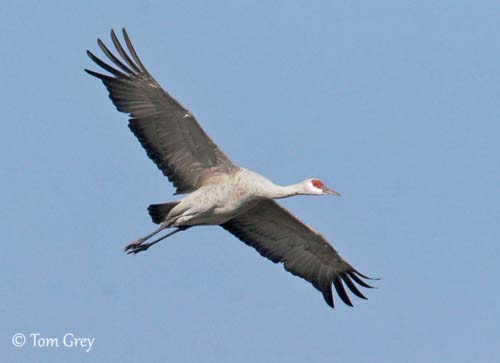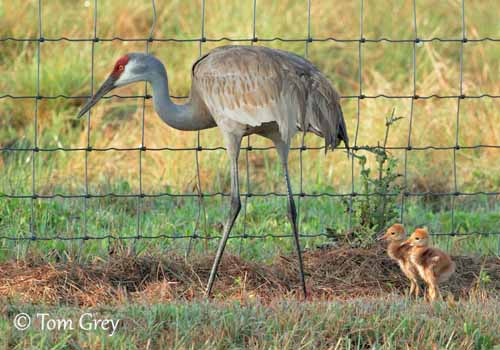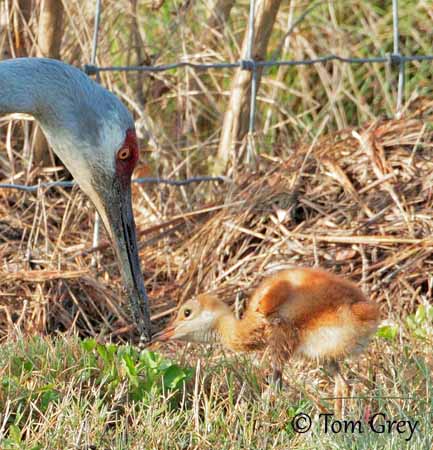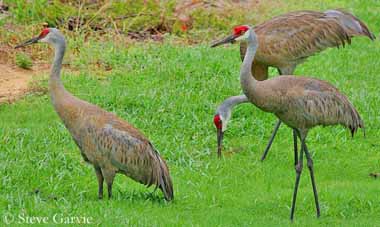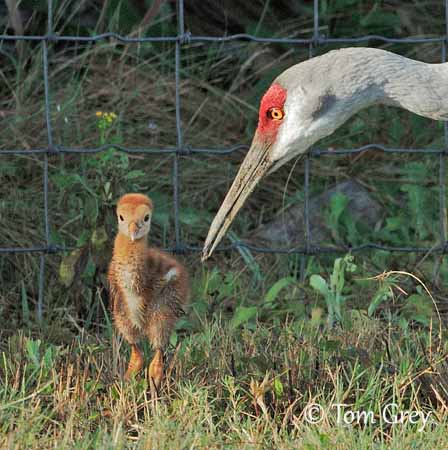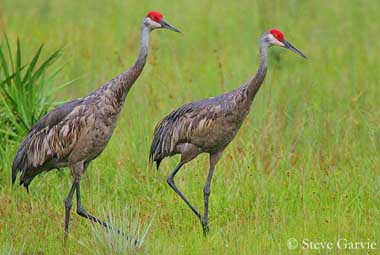
Sandhill Crane
Antigone canadensis
Gruiforme Order - Gruidae Family
BIOMETRICS:
Length: 88-95 cm ; Wingspan: 175-195 cm ; Weight: 3200-5200 g
LONGIVITY: up to 25 years
DESCRIPTION:
Sandhill Crane is a large bird. It has heavy body, long neck and legs. Male and female are similar in appearance, but male is larger than female.
Adult is grey, with dull red skin on crown and lores. It has whitish chin, cheeks and upper throat, and black primaries. The bill is dark grey. Legs are blackish.
Juvenile lacks red patch. Head and neck vary from pale to tawny. Its body is grey but irregularly mottled with brownish red. It has pale bill and blackish legs.
BEHAVIOUR:
By preening with muddy bills, the cranes may stain the feathers of upper back, lower neck and breast, with ferrous solution included in the mud.
Sandhill Crane is monogamous. Breeding pairs remain together from year to year, maintaining the pair bond by performing courtship displays, remaining in close proximity and calling in unison. Sandhill Crane has an elaborate courtship display. Five have been identified, as part of “dancing”, the primary mechanism of pair formation. The others are the upright wing stretch, horizontal head pump, bow vertical leap and vertical toss.
Three courtship displays are exclusively used by paired adults, to maintain pair bond. They are the bill up, copulation and unison call display. They raise one brood per year.
REPRODUCTION:
Sandhill Cranes nest sites are usually in marshes and grasslands, but they will occasionally nest in dry land. Both adults build the nest, using plant material from the surrounding areas.
The female lays 1 to 3 eggs. They are dull brown with reddish brown markings. Incubation lasts 29 to 32 days, both parents share it. Incubation begins with the first laid egg and continues until the last egg has hatched.
Chicks are covered with down, they have open eyes, and are able to leave the nest within 24 hours of hatching. Both parents brood the chicks for up to 3 weeks more.
They feed the young intensively for the first weeks and decrease until they reach independence at 9 to 10 months old.
After leaving their parents, chicks form nomadic flocks with subadults and non breeders. They remain with these flocks until they form breeding pairs between the ages of 2 and 7 years old.
Fr: Grue du Canada
All : Kanadakranich
Esp : Grulla Canadiense
Ital: Gru canadese
Nd: Prairiekraanvogel
Russe: Журавль Канадский
Sd: Prärietrana
Photographers:
Steve Garvie
RAINBIRDER Photo galleries
Tom Grey
Tom Grey's Bird Pictures
Text by Nicole Bouglouan
Sources:
HANDBOOK OF THE BIRDS OF THE WORLD Volume 3 by Josep del Hoyo-Andrew Elliott-Jordi Sargatal - Lynx Edicions, 1996, 821 pages - ISBN : 8487334202
All About Birds (Cornell Lab of Ornithology)
Animal Diversity Web (University of Michigan Museum of Zoology)
The Longevity List (Roland Staav)
Wikipedia (Wikipedia, The Free Encyclopedia)
Bird Web (Seattle Audubon Society)

VOICE: SOUNDS BY XENO-CANTO
Flight call is a rolling “kaar-rooo”, more musical than Common crane. Juvenile gives a thin, high, rolling whistle. Adult Sandhill Crane has more than a dozen calls, some variations on trills, purrs and rattles.
HABITAT:
Sandhill Crane is locally common. It breeds on tundra and in marshes and grasslands. In winter, regularly feeds in dry fields, returning to water at night.
RANGE:
It is resident near the parts of the Gulf coast in Florida and in Cuba. Other North American subspecies are migratory. Very rare during fall and winter on east coast from Massachusetts South. Populations of Sandhill Cranes are also found in northeast Siberia.
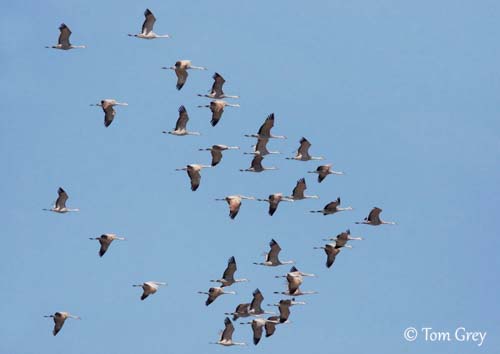
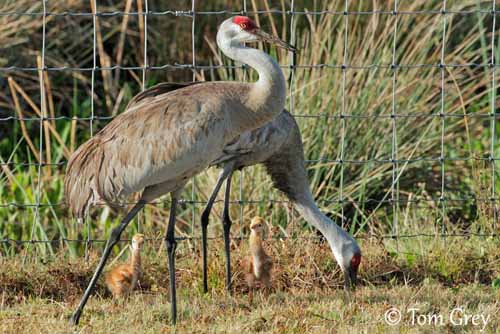
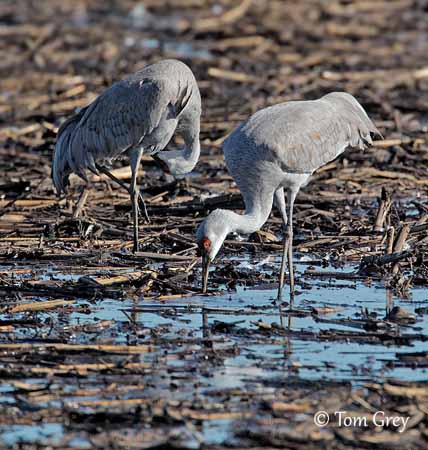
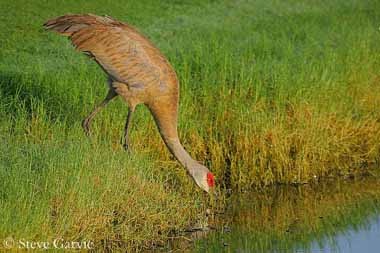
When approached by avian predator, the Sandhill Crane fly at the predator, kicking it with their feet. When it is a mammalian predator, they move towards it, with their wings spread and bill pointed at it. If it persists, the Sandhill Cranes attack, hissing, stabbing with their bills and kicking with their feet.
FLIGHT:
Migrating flocks of Sandhill Cranes fly at great heights, sometimes too high to be seen from the ground. During migration, they fly as in straight line or in V shaped.
Their wing beats are a slow downward beat, followed by a quick upward flick.
